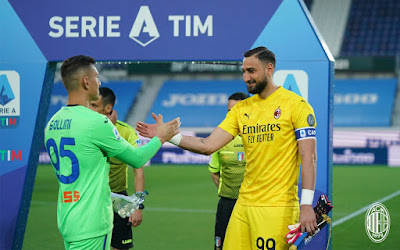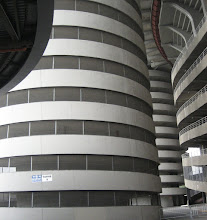Events so far this summer have highlighted the fact that it is virtually impossible for any player to be a bandiera for their club any more. With football driven by money now, transfers are inevitable, making staying at one club for an entire career just a pipe dream. With fans more vocal than ever about players and their demands for their club, the loyalty toward a single player seems to have disappeared from fans as well. Instead of celebrating a player's allegiance to a single club, we find ourselves mourning the lost art of the bandiera.
 |
| The ultimate bandiera |
The Italian word "bandiera" translates directly as flag or banner. More specifically, it is an emblem or a standard to represent something. In calcio, a bandiera is someone who is loyal to one club for their career, and thus becomes a standard to represent the club. Milan's most obvious bandiera is Paolo Maldini. Not only did he come through the youth system and play his entire career for Milan, he is the son of Cesare, who was also a Milan captain and subsequently coached Milan. Even more so, his son Daniel is now at the club, and Paolo has returned as technical director. He is still our bandiera.
Fans may say they are "Milan for life," but no one has given more to Milan, for three generations now, than the Maldini family. Other recent memorable bandiere for other clubs include Juventus' Alessandro Del Piero and Claudo Marchisio, and Roma's Francesco Totti and Daniele De Rossi. Their names are synonymous with their clubs, and they are often the first player that comes to mind when you think about those clubs. Yet even some of them were pushed out by the clubs they loved.
 |
| Bandiere like these two are nearly extinct |
Most recently, I think a lot of us fans, and maybe even some of the fans who abused Donnarumma still expected him to stay at the club forever and become a bandiera. He grew up in Milan's youth sector, debuted very young, and had 251 caps for Milan by the age of 22. The reason he refused Milan's contract offer is still unknown. Many reports indicate that he was still planning to stay, but the club couldn't wait any longer and signed a new goalkeeper.
When Maldini spoke about his exit, he pointed out that it is very difficult for anyone to stay at one club anymore. Modern football is a bunch of moving pieces, and clubs cannot afford to pay players for loyalty. That loyalty may be romanticized by some fans, particularly for players who are talented, likeable, and fit in with the club's ideals as well. That loyalty is at the heart of what makes a bandiera.
 |
| Captain up until his final appearance, but no bandiera |
However, now, media and social media have directly influenced football players, clubs, and the transfer market. Or in the end, a player must be sold, like Shevchenko, Kakà, or Ibrahimovic, to help the club's finances. Or a player falls out with a manager. Or a player needs to move somewhere for family reasons. Or there is a serious injury and the player is no longer able to play at the level needed by the club. Or the player's agent needs a big fat paycheck. Or so many other circumstances that come up which end up separating a potential bandiera from the club they represent.
The bottom line is that warm, happy, comfortable feeling that fans used to get knowing that their favorite player would always be at the club is gone. Our hearts are all hardened by seeing players moved in and out like recycled bags. We may never again see a player like Paolo Maldini in our lineups year after year, giving us hope, comfort, and security, even in uncertain times. That is the toll of modern football, and the lost art of the bandiera.
This post inspired by the music of Gotye's "Somebody That I Used to Know"
 Reviewed by Elaine
on
5:03 AM
Rating:
Reviewed by Elaine
on
5:03 AM
Rating:
